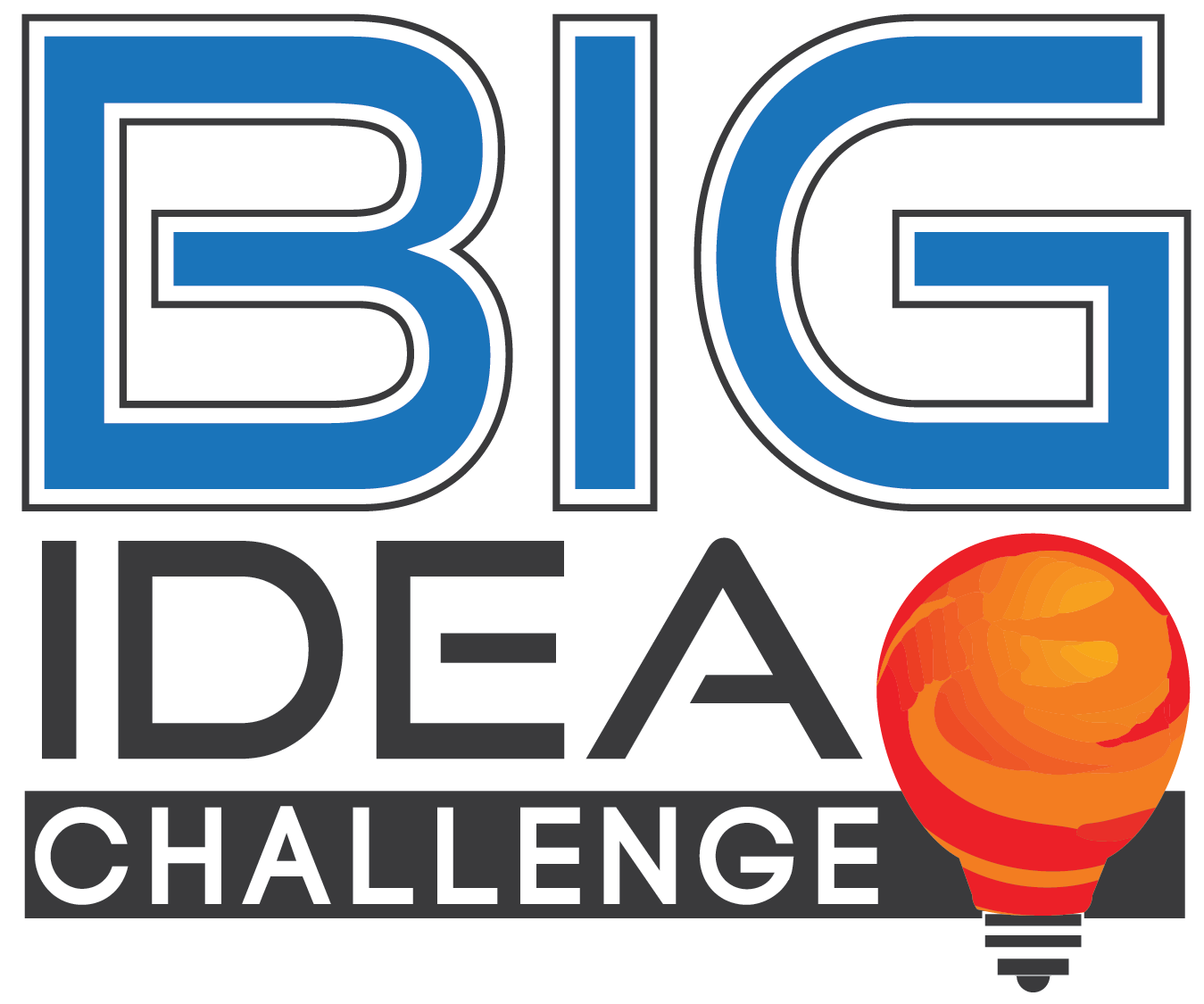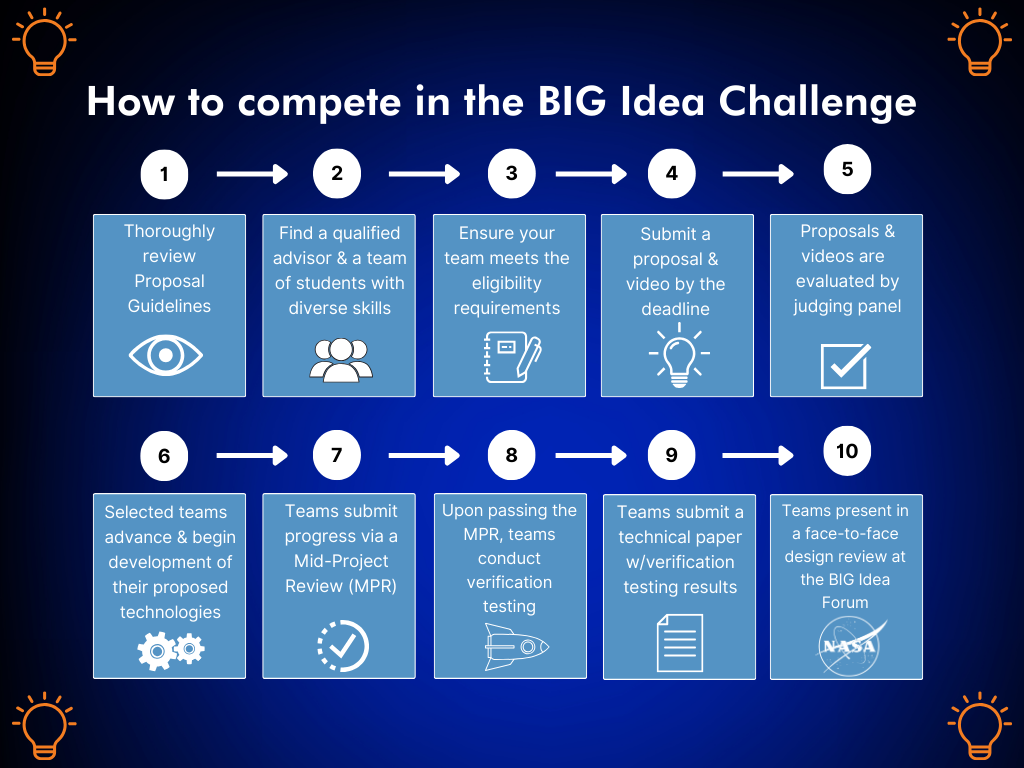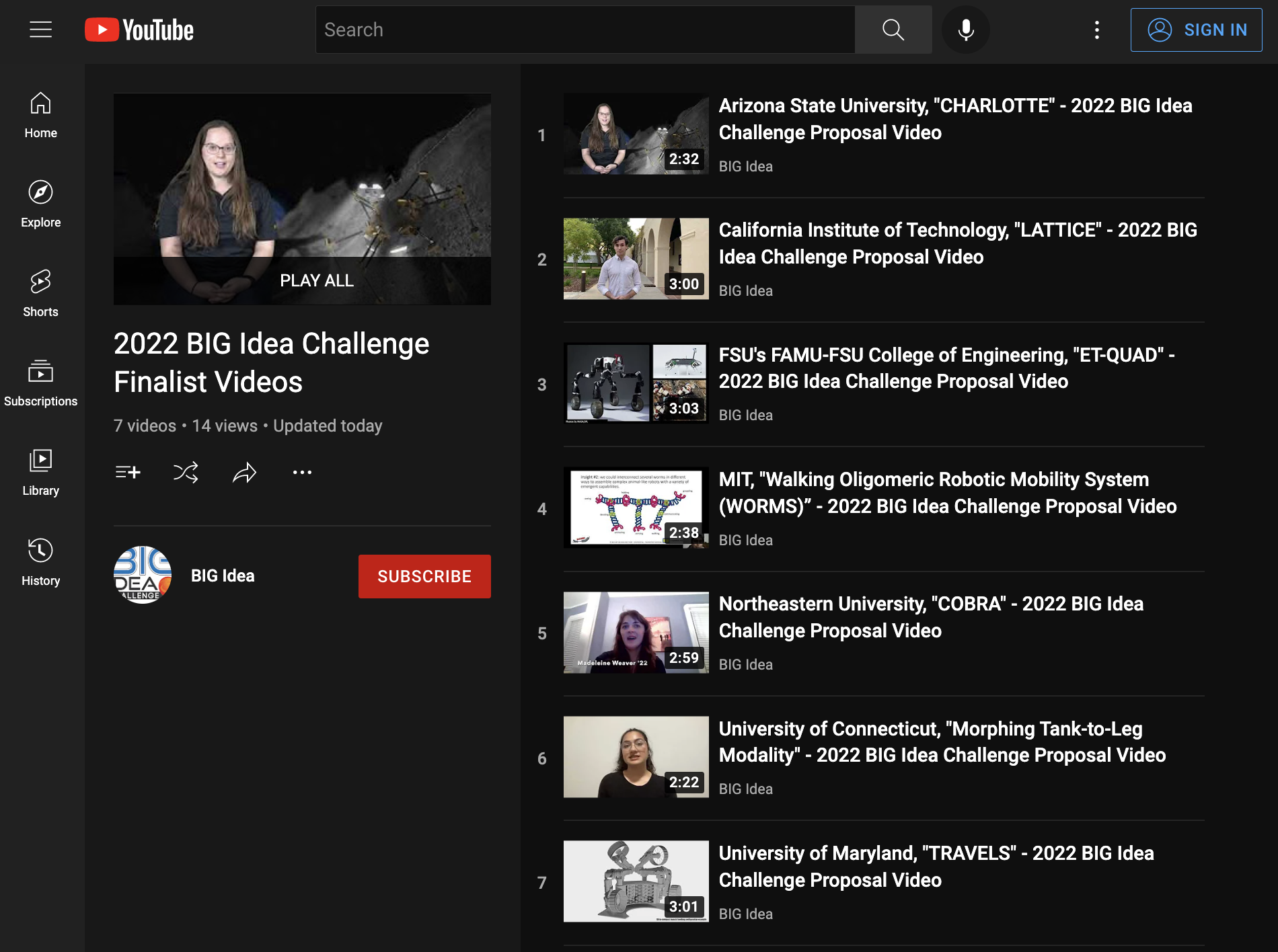THE 2024 BIG IDEA CHALLENGE
INFLATABLE SYSTEMS FOR LUNAR OPERATIONS
Challenge Summary | Submission Forms | More Information | Dates & Deadlines
CHALLENGE SUMMARY
The 2024 BIG Idea Challenge provides undergraduate and graduate students up to $150,000 to design, develop, and demonstrate novel uses of low Size, Weight and Power (SWaP) inflatable technologies, structures, and systems* for lunar operations. This year's challenge invites teams to go beyond lunar habitats, and instead explore innovative concepts incorporating inflatable components, such as: deployable towers, soft robotics, actuators and deployment mechanisms, large antennas and solar reflectors, emergency shelters for extended EVAs, low mass cranes and gantries for offloading and transporting equipment, pressurized tunnels and airlocks, deployable debris shields and dust protection systems, inflatable mandrels for construction, gas or liquid storage tanks and internal or external secondary structures.
*Exclusions: The challenge is NOT looking for concepts that focus on the use of inflatables for lunar habitats.
This is only a brief excerpt of the 2024 BIG Idea Challenge.
Please read the full, printable 2024 Challenge Proposal Guidelines by clicking the link below.
SUBMISSION FORMS FOR FINALIST TEAMS
NOTE: Submissions must adhere to the 2024 Final Deliverables Guidelines.
SUBMISSION FORMS FOR FINALIST TEAMS
NOTE: Submissions must adhere to the 2024 Challenge Proposal Guidelines.
MORE INFORMATION
DIVERSITY, EQUITY, AND INCLUSION
Diversity and inclusion are integral to mission success at NASA (see the NASA Equity Action Plan). The agency recognizes the benefits of having diverse and inclusive scientific, engineering, and technology communities and expects the reflection of such values in the implementation of the BIG Idea proposed solutions. Participation from organizations and institutions that support and serve under-represented groups including Historically Black Colleges and Universities (HBCUs), Hispanic-Serving Institutions (HSIs), Tribal Colleges and Universities (TCUs), and other Minority Serving Institutions (MSIs) is strongly encouraged. NASA has created a resource to facilitate partnering with MSIs through the Minority Serving Institutions Exchange. The inclusion of women, members of underrepresented minority groups, veterans, persons with disabilities, and personnel from MSIs in leadership roles is also strongly encouraged. Multi-university and interdisciplinary teams are encouraged.
ELIGIBILE INSTITUTIONS
The BIG Idea Challenge is open to teams comprised of undergraduate and/or graduate students at accredited U.S.-based colleges and universities officially affiliated with their state’s Space Grant Consortium. Non-Space Grant affiliated colleges/universities may partner with a Space Grant affiliated academic institution who takes a primary role on the project (i.e., the Space-Grant affiliated university must submit the proposal on behalf of the joint team).
TEAM COMPOSITION AND SIZE LIMIT
Team sizes vary widely, but must contain, at a minimum, one faculty advisor from a U.S.-based, Space Grant Affiliated university, and 2 students from that university who work on the project and present at the BIG Idea Forum, each of whom must be U.S. citizens or Lawful Permanent Residents. Teams may include senior capstone students, clubs, multi-university teams, or multi-disciplinary teams.
- Team size is limited to a maximum of 25 student team members.
- Teams will be comprised of a minimum number of 2 U.S. citizen students or Lawful Permanent Residents who can present the teams’ work at the culminating BIG Idea Forum if it is held on-site at a NASA Center.
- A faculty advisor is encouraged to attend the Forum with each team.
- An individual (either students or faculty advisors) may join more than one team.
- A university may submit more than one proposal (multiple proposals may be funded from the same institution).
- While faculty and/or post docs can contribute to the team’s BIG Idea challenge efforts, it is expected that the bulk of the work is completed by the undergraduate and/or graduate students.
SPECIAL NOTES REGARDING FOREIGN NATIONALS
Foreign Nationals (FNs) attending the proposing U.S.-based university can participate on a BIG Idea Challenge team, with one notable exclusion. Due to prohibitive restrictions and ever-changing NASA security regulations, foreign nationals will not be able to attend culminating BIG Idea Forum events that take place on-site at a NASA Center (including tours). There will be no exceptions to this policy. FNs can, however, participate in any portions of the culminating BIG Idea Forum that take place off-Center.
FOREIGN UNIVERSITIES - INELIGIBLE
Eligibility is limited to universities in the United States. Foreign universities are not eligible to participate in the BIG Idea Challenge.
INDUSTRY PARTNERSHIPS ENCOURAGED
Teams are encouraged to collaborate and work in concert with other government or industry partners. An “industry partner” is defined as a non-government business or organization that can provide support to the team in terms of mentorship, access to labs or other facilities, in-kind donations, and/or even financial sponsorship.
Note: Partner vs. Vendor - If a team is paying for a service provided by a specific company (e.g., paying to use a vacuum chamber for testing), the company would be considered a vendor, NOT a partner.
2024 CHALLENGE RESOURCES
More resources will be listed as they are made available.
REPOSITORIES/MULTIPLE RESOURCES
- NASA Technical Report Server (NTRS)
- MAPTIS (Materials and Processes Technical Information System)
- To request access to MATPIS, choose "Register," complete the form being sure to note in the 'Justification' block that you are associated with NASA's BIG Idea Challenge. Your request will be reviewed by a NASA Official.***
- NASA Software Catalog
- NASA Standards by Topic
- NASA Technical Standards
- Quality control training classes: The AAQ (Academy of Aerospace Quality)
- NASA LRO Mission Imagery
- 2020 NASA Technology Taxonomy
WEBSITES/PDFs
- Review of Habitable Softgoods Inflatable Design, Analysis, Testing, and Potential Space Applications
- Bending and buckling of inflatable beams : some new theoretical results
- NASA's Moon to Mars Strategy and Objectives Development document
- NASA Exploration Frontiers Moon to Mars Strategy (2021)
- Strategic Framework: Charting the horizon of NASA technology development
- NASA Cost Estimating Handbook Version 4.0
- The Artemis Plan: NASA's Lunar Exploration Program Overview, September 2020
- Lunar Environment – 2020 NASA Cross-Program Design Specification for Natural Environments (DSNE), Rev. H
- Lunar Sourcebook
- NASA LRO Mission Page
- NASA Technology Readiness Level Definitions
- NASA’s Plan for Sustained Lunar Exploration and Development
- Review of Habitable Softgoods Inflatable Design, Analysis, Testing, and Potential Space Applications
- Bending and buckling of inflatable beams: Some new theoretical results
- Feasibility of a Self-Erecting Shelter with an Inflatable-Fabric-Arch-Supported Roof and Rigid Walls
- Experimental Test Methods for Inflatable Fabric Beams
- Structural Behavior of Externally Reinforced Inflated Fabric Arches and Beams
- Evaluation and Improvements to the Modular Ballistic Protection System Stand Alone Anchoring System
- Structural and Material Characterization of Inflatable Drop-Stitch Panels Used in Bending Applications
- Experimental Methods and Practices for the Study of Toroidal Inflated, Braided Fabric Members
- Mechanics of Plain Woven Fabrics for Inflatable Structures
- Technology & Mechanics Overview of Air-Inflated Fabric Structures
PROPOSAL VIDEO EXAMPLES
BIG Idea Challenge competitors may use the Challenge name, logo, and images below on anything which specifically and positively represents the Challenge. This includes any presentations you do before, during, and after the onsite portion of the challenge.
LOGO
Looking for the BIG Idea logo? Click here!
NASA Logo/Media Usage Guidelines
IMAGES
More images will be added as they are available. Click on an image to enlarge.
DATES & DEADLINES
All deadlines must be met by 11:59 p.m. Eastern Time on the dates specified below, unless otherwise noted.
Late deliverables will not be accepted.
| Date | Description |
|---|---|
| Rolling until Feb. 1 Previously October 22, 2023 | Deadline to Submit a Notice of Intent |
| October 29, 2023 | Deadline to submit questions in advance Submit a Question |
| November 7, 2023 3:00 - 4:30 PM ET | Q&A Session for interested teams |
| February 1, 2024 | Deadline to Submit a Proposal |
| February 29, 2024 | Teams are notified of their selection status |
| Mid-March 2024 | First installment of stipends sent |
| June 4, 2024 | Deadline to submit a Mid-Project Report |
| June 18, 2024 | Teams are notified of pass/fail status |
| Late June, 2024 | Second installments of stipends sent, as appropriate, from Space Grant directly to schools |
| September 10, 2024 | Fall Status Report Deadline |
| October 9, 2024 | Deadline for Forum Registration & Payment |
| October 16, 2024 | Deadline to submit Technical Paper and Verification Testing Demonstration files |
| November 2, 2024 4:00 PM ET | Deadline to submit Presentation Chart Deck and Digital Poster files |
| November 11-12, 2024 | 2024 BIG Idea Challenge Forum (Las Vegas, Nevada) |
Deliverables for Finalist Teams
DELIVERABLES
NOTE: Be sure all submissions adhere to the 2024 Final Deliverables guidelines.


